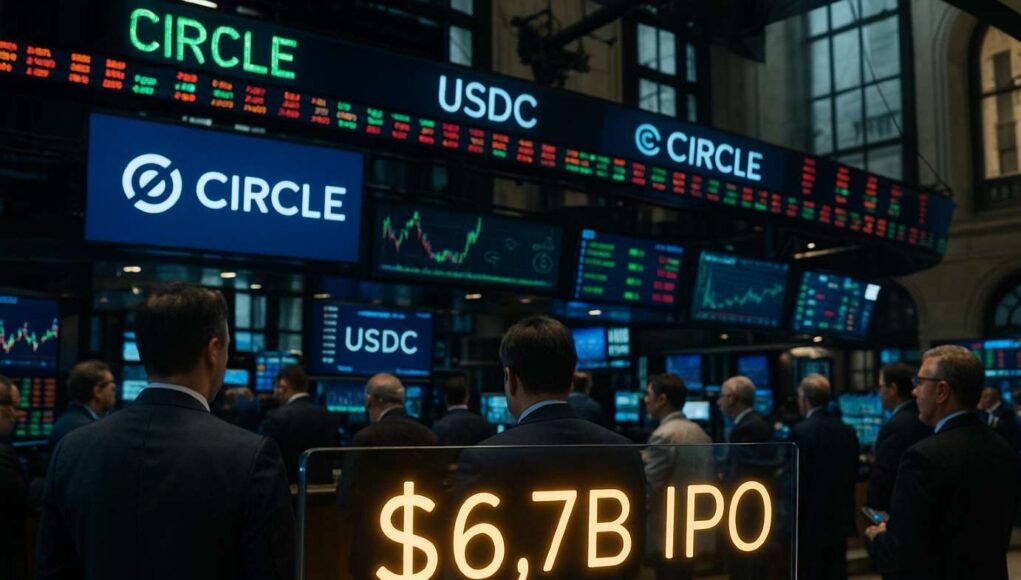Two years after its high-profile SPAC merger fell apart, the Circle IPO is officially back on track; this time via a traditional listing. The USDC issuer has filed to go public on the New York Stock Exchange, targeting a $6.7 billion valuation and aiming to raise $624 million through the share sale. The move signals a recalibrated attempt to anchor stablecoins in the U.S. financial mainstream and reclaim lost momentum after a period of retreat.
From SPAC Failure to Wall Street Debut
In 2021, Circle announced a merger with Concord Acquisition Corp, an SPAC deal that would have valued the firm at $9 billion. However, that agreement unraveled in late 2022 amid regulatory delays and shifting crypto market conditions. Circle quietly withdrew from the spotlight, shelving its ambitions—until now.
The newly filed Circle IPO outlines a leaner offering: 21.2 million shares that could raise $624 million. While the IPO proceeds are modest relative to the overall $6.7 billion valuation, they represent a significant capital injection. More importantly, they mark a renewed push to bring Circle stablecoin operations under public scrutiny.
The listing will include dual-class shares, a structure that grants insiders greater voting power. This detail has drawn comparisons to Facebook’s IPO and sparked some governance concerns.
Stablecoin Strategy in a Post-Terra Era
Circle’s revival comes as the stablecoin sector fights for credibility. Since TerraUSD’s collapse in 2022, scrutiny over reserve backing and systemic risk has intensified. USDC, backed by U.S. dollar reserves and Treasury assets, has retained its position as the second-largest stablecoin, with a supply of roughly $32 billion as of May 2025. That figure, however, is down sharply from its peak of over $55 billion.
The Circle NYSE filing presents the IPO as a milestone that could fortify USDC’s legitimacy. In an environment of tightening stablecoin regulation, going public may be as much about transparency as it is about raising funds.
Strategic Allies and Market Appetite
Investor demand for the Circle IPO appears robust. According to reports, the offering is already “multiple times oversubscribed,” indicating strong market interest. The IPO also brings renewed attention to Circle’s institutional backers, including Coinbase and Goldman Sachs. These relationships deepen the connection between Wall Street and the crypto ecosystem.
The Coinbase Circle IPO link is particularly notable. Coinbase not only holds a strategic stake in Circle but also plays a role in USDC’s ecosystem. Meanwhile, Goldman Sachs crypto investments underscore growing traditional finance interest in digital payment infrastructure.
IPO or Exit? Rumors of Acquisition Talks
While Circle publicly moves forward with its IPO, some reports suggest the company may have explored other strategic options earlier this year. The USDC issuer was reportedly approached with acquisition offers, including from major players in the crypto industry such as Ripple and Coinbase. The company has not publicly addressed these rumors, and the talks were never confirmed. Still, the timing of the Circle IPO raises questions about whether the move is aimed at strengthening its market position or gaining leverage for future negotiations.
>>> Read more: Coinbase’s S&P 500 Entry Sparks Investor Enthusiasm
The Circle IPO represents more than a capital raise, it’s a second chance for the USDC issuer to prove its relevance and resilience in a maturing crypto landscape. With a $6.7 billion valuation goal and strategic Wall Street backing, Circle is betting that public accountability will translate into long-term credibility. If successful, the Circle stablecoin strategy could set a precedent for future stablecoin IPO efforts amid intensifying regulatory scrutiny.
Readers’ frequently asked questions
How does Circle’s IPO affect USDC holders?
While the IPO doesn’t change how USDC operates directly, going public may increase transparency around Circle’s reserves, audits, and financial health, potentially boosting trust in USDC.
What risks come with Circle’s dual-class share structure?
A dual-class setup gives founders and early investors outsized voting power, limiting the influence of public shareholders. Some investors see this as a governance risk, especially if strategic decisions become controversial.
Could Circle still be acquired after the IPO?
An IPO doesn’t prevent acquisition, but it becomes more expensive and visible. If a buyer like Ripple or Coinbase remains interested, any future deal would require shareholder approval and public disclosure.
What Is In It For You? Action Items You Might Want to Consider
Track the Circle IPO listing date and investor disclosures
If you’re interested in the evolution of regulated stablecoins, monitor the official Circle IPO filings and listing updates on the NYSE. These documents can reveal insights about revenue streams, token economics, and risk factors.
Evaluate USDC’s market position post-IPO
Keep an eye on how the IPO affects USDC adoption across exchanges and DeFi platforms. Public accountability could boost confidence or expose new vulnerabilities.
Watch for regulatory responses to Circle’s listing
The Circle IPO may influence how U.S. regulators approach stablecoins going forward. Traders should monitor any changes in legislation or enforcement that could affect USDC or similar assets.











[…] contrast, Circle, the issuer of USDC and EURC, has built a reputation for transparency and regulatory alignment. The company publishes regular […]
[…] 44.7%, propelling the company’s market cap to nearly $25 billion. That’s a remarkable turn from its original IPO pricing, which had been relatively modest given recent crypto market […]
[…] for crypto-related listings. Analysts view the strong demand as an encouraging sign for the sector. Circle, the issuer of USDC, already completed its IPO earlier this year, while Gemini is preparing for a potential debut. Together, these moves highlight a broader shift […]